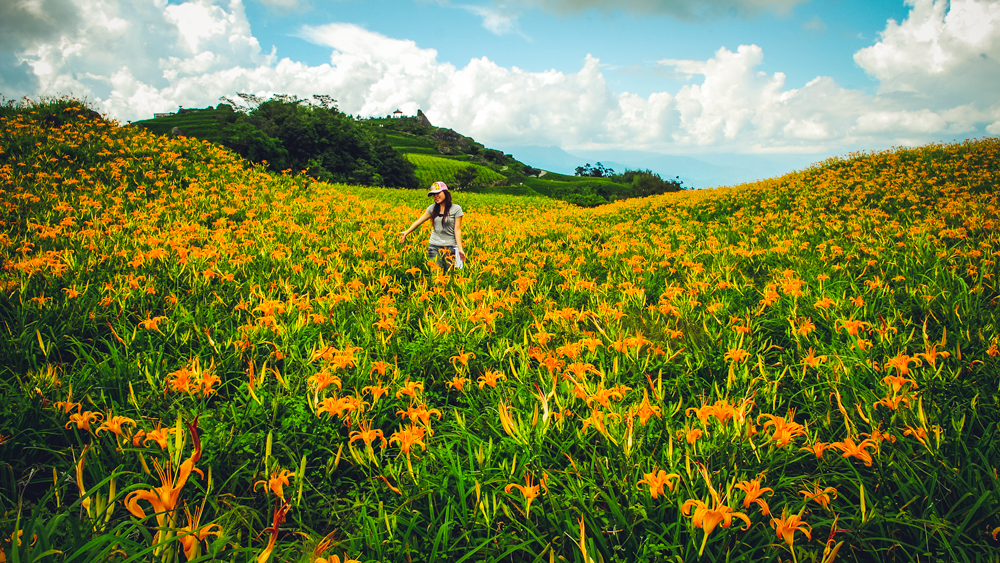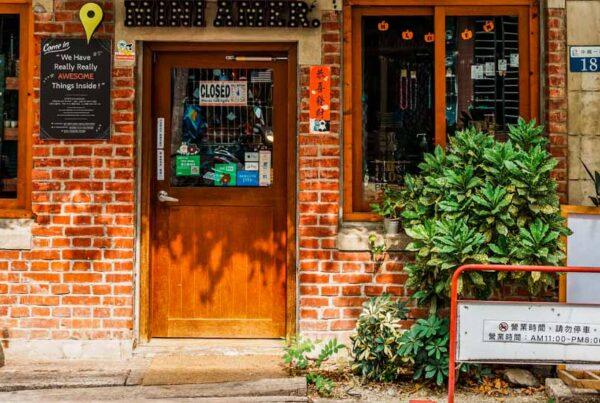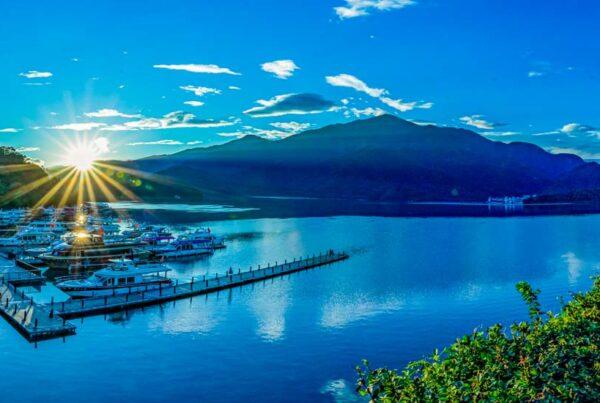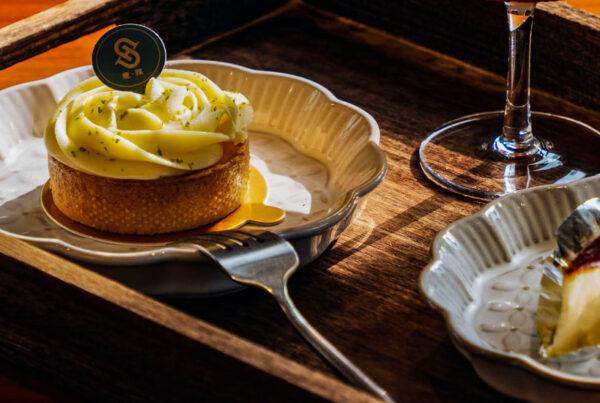Taiwan in Full Bloom on the International Stage
TEXT: RICK CHARETTE; PHOTOS: CHEN CHENG-KUO
Taiwan has a flourishing floriculture industry, and throughout the year are large-scale celebrations of the joys that floral beauty brings to our lives. So whichever time of year you visit, flower-appreciation opportunities await. An especially grand one-time spectacle happening right this moment is the Taichung World Flora Exposition.

In a “sea of flowers” (Xinshe)
Subtropical Taiwan, tropical in its far south, is an unusually fecund place. A welterweight in terms of size, it punches far above its weight in the international agricultural arena. Affectionately dubbed the “Kingdom of Fruit” by islanders – if you visit, don’t miss out on the tremendous range of flavors available, including in the delicious “fruit cuisine” – another moniker, the “Kingdom of Flowers,” would also be apt. The government actively supports the cash-crop flower industry, and over the past few decades great strides have been made in terms of both variety and quality, with exports growing substantially as a result.
The island’s status on the global flower-production stage has been recognized in the past decade with the bestowal of two coveted bouquets by the International Association of Horticultural Producers (AIPH), which defines itself as “the world’s champion for the power of plants” – the choice of Taiwan as host venue for two major international horticultural exhibitions. The first was the 2010 Taipei International Flora Expo, and the island is once again in full bloom on the international stage with the city of Taichung now proudly hosting the 2018 Taichung Flora Expo.
In the pages to follow we present a primer for international tourists interested in visiting the 2018~2019 mega-happening, and we follow this with quick visits to a number of other island garden spots where annual flower-theme celebrations attract visitors in great numbers.

The Sound of Blooming installation (Forest Expo Site)
Taichung Flora Expo
The doors were officially swung open on this multi-month explosion of floral pastels on November 3 last year. More formally called the 2018 Taichung World Flora Exposition, the goal of the organizer is to match and perhaps best the total of just under 9 million local and international visitors chalked up at the stupendously successful 2010 Taipei International Flora Exposition. Let’s just say the cities of Taichung and Taipei have long been engaged in friendly competition. Surveys show that many people in Taiwan consider Taichung its most livable city.
The jubilant color-fest runs until April 24, so you’ve still plenty of time to get yourself to one of the island’s international-travel portals and on to Taichung. Well-served by international airlines Taiwan has an excellent domestic transportation network. English signage aplenty all along the way will also make getting to Taichung and around the expo sites a comfy experience.

Discovery Pavilion (Forest Expo Site)
The event organizer is the Taichung City Government. The Agriculture and Food Agency of the central government’s Council of Agriculture is co-organizer. In the run-up to the opening day they proudly declared this the “biggest theme event in Taiwan in 2018,” and visitor numbers since the beginning of the event have proven them right. The three expansive expo sites are in semi-rural districts northeast of the city center. The Houli Horse Ranch Area & Forest Expo Site measures 30.04ha in area, the Waipu Park Area 14.32ha, and Fengyuan Huludun Park 16.52ha.
The city government has two prime goals in hosting this event and spotlighting these enclaves. The first is the enhancement of Taichung’s international visibility. The second is a comprehensive re-crafting of the local landscapes, making them more inviting for both residents and visitors. The spirit of sustainability was at the core of all planning, in keeping with Taichung’s quest to transform itself into a “sustainable and people-centered flower city,” with post-expo reuse of facilities a key. “This expo,” proclaims the organizer, “offers reflections on the beauty of harmonious development between green production, natural ecology, and human life.”

Old trees and the Greenway (Forest Expo Site)
Centered in and spilling over the sides of a shallow mountain basin just off the central-west coast, Taichung enjoys abundant sunshine and a reputation for Taiwan’s most pleasant weather. Said pleasant climes and fertile soil have sprouted blooming cash-crop productivity, including intensive and growing cultivation of flowers and ornamental plants. This floriculture-industry prowess is both what has made the 2018 expo extravaganza possible and is the raison d’etre behind Taichung petitioning the AIPH to make it a showcase venue.
Adding to the festive entertainment at this floral jubilee is an endless stream of live cultural-arts performances collectively celebrating Taichung’s culture and history. By the expo’s denouement visitors will have been entertained with over 1,200 theatrical performances and 14,000 street-artist shows.
Houli Horse Ranch & Forest Expo Site
The theme for this attraction is “Horse Ranch and Flower Paradise / Ecosystems-Nature-Coexistence.” To handle the streams of visitors the Greenway was created, connecting the two areas, which are separate, with each other and with a shuttle-bus station at Houli Railway Station.
A section of this route will become an extension of another local tourist attraction, the Dongfeng Bikeway, after the doors are closed on the expo. Horse-riding and cycling are culturally iconic recreational pursuits in the Houli area, and the emphasis with the local bikeway network is on slow-paced enjoyment of pastoral scenery and railway history. The 4.5km Houfeng Bikeway takes riders from the Houli Horse Ranch to and through an old railway tunnel and then leaps the Dajia River on a lengthy steel-frame bridge that was also part of the old rail line. Complete the Houfeng circuit, or if abloom with energy switch at the connection with the longer Dongfeng Bikeway for a level-grade 18km excursion.
What is perhaps the most brightly coruscating diamond of the entire expo is the modernistic Blossom Pavilion, a large purpose-built two-floor architectural beauty in the Houli Horse Ranch expo area. The larger of its two halls is the Orchid Hall, a greenhouse facility that tells the story, in brilliant pastel hues, of Taiwan’s orchid industry and “Kingdom of Orchids” reputation. The Competition Hall serves as a wonderful chorus-line showcase of entrants created by local and international masters for floriculture competitions, demonstrating creative-design possibilities for people’s backyards, courtyard gardens, etc.
The forest expo area is on a former army-barracks site rich with soaring old trees now transformed into a “Big Tree Community.” Within it, among the more compelling draws are the Amazing World of Taiwan Indigenous Cultures, the large A Seed from the Sky installation artwork, and the World Gardens, featuring installation artworks by teams from around the world celebrating the culture and floriculture of their respective homelands.

A Seed from the Sky

A New Vision interactive visual show

Stage of The Amazing World of Taiwan Indigenous Cultures

Horse sculptures at Houli Horse Ranch

A real horse

Merry-go-round for children and rest area
Waipu Park Area
The theme here is “The Flower and Fruit Village / Production-Green-Sharing.” Taichung’s advantageous climate and topography has given birth to robust clusters of fruit-growing and flower-cultivation enterprises, with demand for their premium-quality offerings from around the globe. The most important cultivars at farms in the Waipu area are lilies, dancing-doll orchids, and flamingo flowers. Major fruits include lychees, dragon fruits, honey tangerines, and ponkans.
The exhibition halls in each expo area showcase the newest ideas and technologies related to that area’s major theme. There is strong emphasis on 3G (Green building, Green energy, and Green transportation) at the Waipu halls. The Green Pavilion and Nature House exhibit agriculture 4.0 technologies used in development of smart agriculture adhering to the “slow food and slow living” worldview.
Also strongly emphasized is this site’s holistic design is 3R (Reduce, Reuse, and Recycle), and outside the exhibition halls are two especially visually compelling locations that serve as concept manifestations: the Water Recycling Bamboo Dome and the Aquatic Viewing Walkway. The dome, 18m in diameter, is made of woven bamboo and covers the site’s wastewater-treatment facility, which is surrounded by a pond, symbiotic plants, and a vanilla garden to create a pleasant environment. The walkway cuts through an eco-pond which, among its varied uses, helps keep ambient temperatures cooler. The corridor’s below-surface-level windows allow visitors to view aquatic life below the ripples.

Pavilion at Flower of Life plaza

Inside the pavilion

Leo the Scarecrow

Harvest Blessings Pavilion

Water Recycling Bamboo Dome
Fengyuan Huludun Park
The clarion call here is “Floral Metropolis by the Water / Life-People-Mutual Good.” Huludun Park is an elongated, landscaped park in Fengyuan District that follows the two sides of a small river. It is divided into five areas. Areas 1 through 4 celebrate the iconic characteristics that help to define Taichung, which in recent decades has been hard at work seeking to redefine its character, transforming from a working-class city into an oasis of cultured living where “green land, nature, and people” exist in symbiosis.
Area 5 is centered on a scenic lake with flower-covered waterfront, where improvements have been carried out to enrich the diversity of Taichung’s eco-habitats. A unique grouping of 10 floral-landscape features demonstrate a new perspective on what a Taiwan urban-area waterfront environment can look like: an island at the lake’s center, a lakeview platform, ecological pavement, an art wall, a “vanilla maze,” a vine tunnel, riverbank grassy areas, a “citizens’ lawn,” and a music plaza.
Riverine Huludun Park has been refashioned to form a holistic ecological system, with planted trees, plants, and flowers forming a natural forest-like water-circulation system that reduces the urban heat island effect and attracts birds along with pollinating butterflies and bees to make the micro-environment self-sustaining.

Bamboo Pavilion

Huludun Park in Fengyuan

Ruanpizai River
For more information on all expo matters, visit 2018floraexpo.tw. Note that railway stations and major highways are located close to each park area, and access using public transportation is strongly recommended, along with the dedicated expo shuttle-bus services.
The Sea of Flowers in Xinshe Festival
Taichung’s Xinshe District, located east/southeast of the flora expo areas, is a rural district on a plateau area in the foothills east of the urban core. Known for farm production, the main products grown here are mushrooms, citrus fruits, grapes, carambolas, pears, loquats, sugar apples, pineapples, persimmons, bonsai – and flowers. Xinshe is today commonly referred to as “Taichung’s back garden.”
The festival is held late each autumn on the grounds of the Taiwan Seed Improvement and Propagation Station, established by the Japanese under a different name during Taiwan’s 1895~1945 Japanese colonial period. The first edition was held in 2005 in an effort to create greater “brand” visibility for Xinshe produce and boost its leisure-agriculture industry. Large swaths of colorful flowers are planted over 30 hectares of showpiece fields – including sunflowers, lavender, cosmos, spider flowers, sage, and begonias – and a series of related events staged.
Each year the festival’s various specially-themed exhibition areas are designed to highlight the area’s unique attributes, dubbed with such enticing names as Happy Farming Villages Exhibition, Incredible Fern Exhibition, and so on. While the hours away learning about paddy-rice production, from transplanted-seedling stage to maturity, the seemingly countless herbs eaten by Taiwan folk in tonic foods and used in medicines, with over 1,000 herbs on display, and much more. Invariably the most popular draw is the orchid in all its glory, with numerous rare specimens on dramatically colorful display.
In addition, live performances are staged on weekends throughout the festival, with an emphasis on music concerts. There are also in-depth local tours offered in which your guide takes you to visit area recreational farms, and special packages are designed each year that encourage you to stay at the local cottage-style guesthouses, visit the local recreation/resort farms, and take in other local tourist attractions. For more info on the festival, visit flowersea.tw.

Sea of Flowers in Xinshe Festival
Yangmingshan Flower Season
Each spring the slopes of the Yangmingshan massif, on the city of Taipei’s northern side between the Taipei Basin and the big blue sea, burst into brilliant floral bloom, the mountain-cherry blossoms, azaleas, camellias, and peach blossoms opening in succession.
The crowning jewel of the massif, and one of the crown jewels of Taiwan’s wonderfully varied system of national parks and national scenic areas, is Yangmingshan National Park (ymsnp.gov.tw), which – to this food-loving writer’s way of thinking – covers the upper portion of the massif in the same manner as the chocolate fudge crowns an ice-cream sundae.
The main venue of the annual springtime Yangmingshan Flower Season is Yangming Park, which in turn is one of the key attractions within Yangmingshan National Park. It is an expanse of 100 hectares that features a famous Flower Clock, fountain, landscaped-garden theme areas, azalea-camellia garden, cherry blossom forest, peach blossom forest, water-curtain tunnel, and many other unique scenic attractions. This is a mystic up-in-the-clouds realm of landscaped waterfalls and ponds, gardens and grottoes, and brilliant floral colors.
The budding and bursting to life of the mountain flora is everywhere around you: azaleas, camellias, peach blossoms, Chinese hydrangeas, and a world of other colorful plant residents. This is the true portrait of spring, and amidst the endless palette of bright color it is the cherry blossom that most charms and bedazzles the visitor. As in many other of Taiwan’s high-mountain areas, the colonial Japanese planted cherry trees in number to remind them of home.
In addition to enjoyment of the flower-theme landscaping at Yangming Park, Qianshan Park, and other locations, there are also floral-theme guided tours, a street-parade carnival staged by local schools, and weekend/holiday musical performances by Yangming Park’s Flower Clock.

Flower Clock at Yangming Park

Cherry blossoms in Yangmingshan National Park
Zhuzihu Calla Lily Festival
Also occurring each spring, and also in Yangmingshan National Park, is the Zhuzihu Calla Lily Festival. Zhuzihu is a peak-surrounded basin high up on Yangmingshan drained long ago by the Japanese, who desired the fertile earth here for agricultural experimentation. Today the quiet basin is filled with small cash-crop tourist farms growing flowers and vegetables. In spring the fields fill up like a waving sea with the pure-white, delicate calla lily, which look like celestial fairies beckoning.
Zhuzihu’s cool and moist weather makes it an especially inviting home for the calla lily, and this is in fact Taiwan’s most important production center for the flower, providing 80%. You can pick your own calla lilies, and can also buy cut flowers, potted flowers, and all sorts of other potted plants, including herbal plants. This is one vast, unified market, filled with color and hubbub.
Festival highlights include a calla lily landscape floriculture-design competition, special calla lily-theme exhibits, colorful floral-theme parades, in-depth guided tours of Zhuzihu, and calla-lily eco-tour outings. As well, explore the various streamside trails that the city government has established on the basin’s periphery, all near the farms. The walks take anywhere from 10 to 50 minutes, and along the way you get good looks at the calla-lily fields, farm terracing, and mountain backdrop.

Snow-white calla lilies

Path along calla lily fields
Hualien Orange Daylily Season
Mt. Liushidan (Sixty Stone Mountain) and nearby Mt. Chike, located in eastern Taiwan’s Hualien County, overlook the bright-hued checkerboard of farm fields on the floor of the East Rift Valley (www.erv-nsa.gov.tw). Each year, during the August/September bloom season of the daylilies cultivated on their slopes, the mountains are painted orange, creating some of the most enchanting scenes found in a region renowned for bucolic visual pleasures. Tourists flock to this comparatively isolated and pristine area from the island’s more heavily populated western side and northern end.
The peak of Sixty Stone Mountain is about 800 meters above sea level, and a 300-plus-hectare rolling tableland of daylilies carpets its farm-populated top. The photographic mood of the setting changes constantly, with repeated and rapid changes between blue or cloudy skies above and thick, rolling mists either creeping or surging up from below. Enhancing the mise-en-scenes even further are the area farmhouses with roofs and courtyards covered with harvested daylily buds spread out to sun-dry.
Visitors also discover that blooming daylilies are more than just visually alluring floral belles. They’re also delicious, and local eateries serve them up in various ways, including deep-fried, in soups, and in teas. The limited number of eateries up on the tableland also serve up especially appetite-stimulating views. Other flower-season enticements include DIY daylily picking, nighttime eco-tours, and stargazing.

Orange daylily field at Sixty Stone Mountain

Daylily fields and views of the East Rift Valley
Taiwan Flower Viewing Through the Seasons
The list of large-scale flower-appreciation celebrations is too long, and the list of flower types being appreciated also too long, for us to delve into at any length here. Suffice to say, however, that whatever the season you visit Taiwan there will be numerous options. To give you an idea, let’s selectively open a window on events in Taiwan’s wonderful world of national scenic areas, national parks, and national forest recreation areas (those presented earlier not included), which come with a solid choice of quality accommodations and are well served by the Taiwan Tour Bus service (www.taiwantourbus.com.tw) and local Tourism Bureau-vetted travel agencies offering guided bus tours to foreign tourists.

Blooming cherry trees, always a delight
In winter, enjoy the mountain cherry and Yoshino cherry blossoms in the Alishan National Scenic Area (NSA) and rapeseed flowers in the East Rift Valley NSA. In spring, savor the peach blossoms in the Lishan Scenic Area (Tri-Mountain NSA) and azaleas at Hehuanshan National Forest Recreation Area. In summer, delight in the lotus flowers in Baihe Township (Siraya NSA). In autumn, take in the cosmos flowers at Wuling Farm and Fushoushan Farm, the latter in the same NSA, and Chinese silvergrass flowers up on Yangmingshan.
About the author

Rick Charette
A Canadian, Rick has been resident in Taiwan almost continually since 1988. His book, article, and other writings, on Asian and North American destinations and subjects—encompassing travel, culture, history, business/economics—have been published widely overseas and in Taiwan. He has worked with National Geographic, Michelin, APA Insight Guides, and other Western groups internationally, and with many local publishers and central/city/county government bodies in Taiwan. Rick also handles a wide range of editorial and translation (from Mandarin Chinese) projects.
















